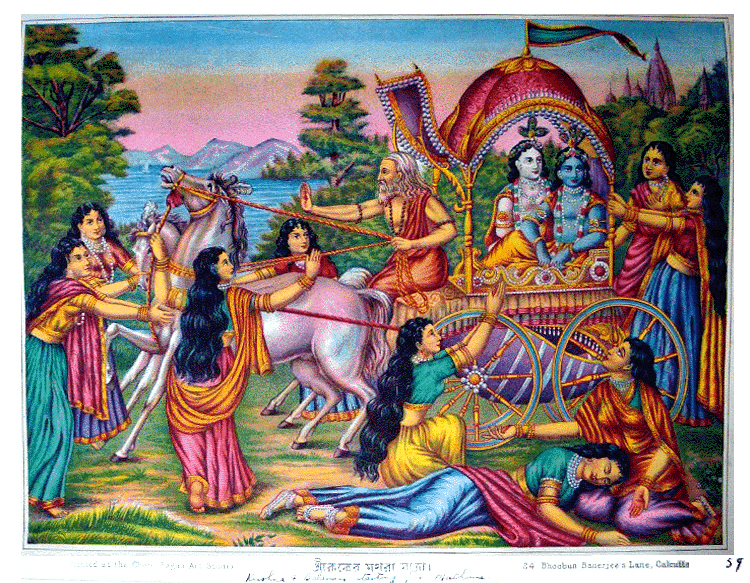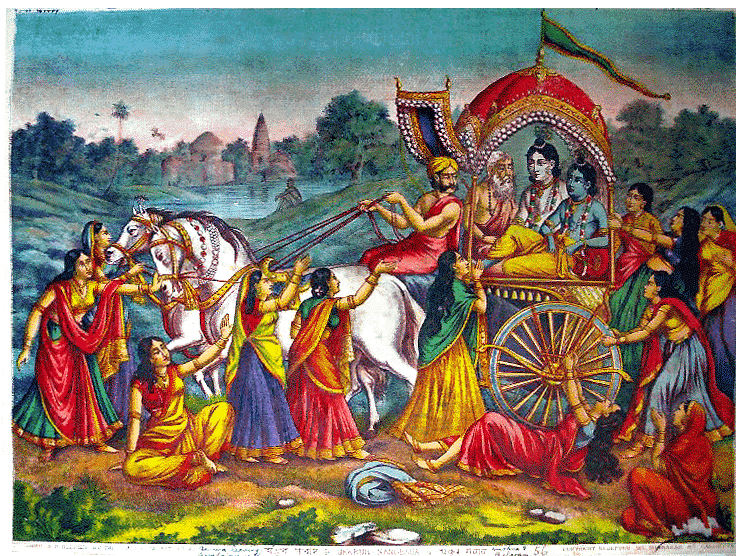
|
|
|
|
BY: SUN STAFF

Krishna and Balaram Starting for Mathura Apr 16, 2011 — CANADA (SUN) — A study of the historical, spiritual and cultural elements of Vedic design. Today we conclude our study of design motifs as incorporated into the lithographic prints of the Chore Bagan Art Studio and other Calcutta art presses of the day who produced similar works. In yesterday's segment, we compared a Chore Bagan print to one from the Calcutta Art Studio which depicted the same scene – Lord Caitanya's Sankirtan party. Today we make a similar comparison of prints from the same two studios, this time the scene of Akrura driving Krsna and Balarama to Mathura. The primary point we've attempted to emphasize in making these comparisons is that many of the Calcutta art presses in the late 1800's were reproducing prints of the same popular scenes, whether they be Sri Krsna's Vrindavan-lila, Gaura-lila, the Dasavatar, or other Vaisnava pastimes. It's interesting to note, however, the unique elements that were added by the studios, who naturally tried to differentiate themselves in a competitive marketplace for religious art prints, and particularly which elements were closely copied, and which were entirely unique. Today's scene of the Lord's departure from Mathura is another good example. In yesterday's segment, we pointed to the ways in which color was employed by the artists in their Sankirtan tableaus. In that instance, the Chore Bagan print used more traditional, muted colors, while the Calcutta Art Studio (CAS) showed a vivid violet color for Lord Caitanya's clothing.

Akrura Leaving Vrindavan with Krishna and Balaram In the Mathura scene, we see that just the opposite is true. The colors used in the CAS print are bright, but still typical of the flat colors of lithographs of the day. The Chore Bagan scene, on the other hand, uses more vivid colors, with more shine, including the violet shades we saw in yesterday's Sankirtana image. We can safely assume that the artist for each press was making an overall creative statement about the scene itself, using color to enhance the narrative. At the same time, they were employing different printing techniques to get the desired results. During the late 1800's, both the Chore Bagan and the Calcutta Art Studio produced prints using the chromolithography process, although Chore Bagan seems to be recognized as more of a pioneer in that field of practice. It is the chrome – a chemical treatment of the color pigments – that produces brilliant colors like the violet shades we've been pointing out. In the case of the Mathura scene, it was Chore Bagan who produced the print as a chromolithograph, and CAS who produced the more traditional lithography. Obviously, the chromolithograph has a more modern look, and the regular litho a more traditional, 'old school' quality. And, we can see that the artists presented the Mathura scene in ways that were true to their chosen printing process: the CAS litho is more traditional in many regards than the Chore Bagan chromolithograph, which followed the trend of more modern motifs in depicting the traditional Mathura departure scene. Yesterday we pointed out the peculiarly interesting fact that the artist of the more recent of the two Sankirtana scenes included an obviously duplicated element: the red and gold mottled dhoti of one of the Vaisnavas in the party. In the Mathura scene, we have a similar mark of obvious duplication, this time in the canopy of the chariot. We say this is an obvious duplication because the chariot canopy itself is not so singularly traditional that it would be unusual to see another design or style of canopy. The placement of the two chariots in the scene are nearly identical, as are their canopies. Both canopies are ornamented in the same way, with a different interior color above Akrura's head than that shown on the canopy's topside. Both feature a long, waving pennant, and the flag plays an important element in the pastime itself, as we read in HDG Srila A.C. Bhaktivedanta Swami's purport to Chapter Thirty-nine of Krsna Book: "The gopis cried all night before the departure of Krsna. As soon as the sun rose, Akrura finished his morning bath, got on the chariot and began to start for Mathura with Krsna and Balarama. Nanda Maharaja and the cowherd men got up on the bullock carts, after loading them with milk preparations, such as yogurt, milk, ghee, in big earthen pots, and began to follow the chariot of Krsna and Balarama. In spite of Krsna's asking them not to obstruct their way, all the gopis surrounded the chariot and stood up to see Krsna with pitiable eyes. Krsna was very much affected upon seeing the plight of the gopis, but His duty was to start for Mathura, for this was foretold by Narada. Krsna, therefore, consoled the gopis. He told them that they should not be aggrieved; He was coming back very soon after finishing His business. But they could not be persuaded to disperse. The chariot, however, began to head west, and as it proceeded the minds of the gopis followed it as far as possible. They watched the flag on the chariot as long as it was visible; finally they could see only the dust of the chariot in the distance. The gopis did not move from their places but stood until the chariot could not be seen at all. They remained standing still, as if they were painted pictures. All the gopis decided that Krsna was not returning immediately, and with greatly disappointed hearts they returned to their respective homes. Being greatly disturbed by the absence of Krsna, they simply thought all day and night about His pastimes and thus derived some consolation." Most elements in the scene are presented in traditional fashion in both prints. The CAS rendition includes three more gopis than the Chore Bagan, and also has the addition of a personality standing beside the chariot, presumably Nanda Maharaja. Krsna and Balarama are in a relaxed, conversational pose, facing Akrura, while in the Chore Bagan image they are sitting more formally, facing outward through the open chariot side. There are a number of other elements worth mentioning that lend themselves to a more traditional scene, in the case of the CAS print, as opposed to a more contemporary rendition in the Chore Bagan. Both prints have Akrura driving two horses who draw the chariots, but the Chore Bagan horses are much more animated, as is the driver – Akrura is holding up a hand, indicating the gopis should stop barring their way. Also interesting to note are the differences in Akrura himself; he appears more similar to Nanda in the Chore Bagan print. The gopis are in various states of expressing their despair, blocking the horses with their hands, or y sitting on the ground; holding the chariot wheel or frame. In one scene, there is a sari lying on the ground; in the other, a gopi is lying on the ground, overcome with sadness. Although we see traditional Mathura-style temples in the background of both prints, the Chore Bagan also includes their signature landscape of distant hills reminiscent of the lofty peaks of the Himalayas. Finally, we note some of the more modern elements included in the Chore Bagan print. The four-wheeled chariot (as opposed to two wheels) has a band of striped violet fabric as an under-canopy. These stripes are subtly mirrored in the fabric of the gopis, whose clothing is less traditional than in the CAS print. Similarly, all the gopis in the Chore Bagan scene have their long hair down, while several of the gopis in the CAS print have their hair up, or covered with their sari pallu. Together, all these factors provide an excellent example of how design motifs are employed in concert with a particular lithographic printing technique employed by the press. Although both artists have provided a rendition of the 'Departure for Mathura' scene that is true to sastra, they have managed to incorporate a surprising range of artistic technique in making the scene their own. And both, without a doubt, inspire our Krsna consciousness.
| |